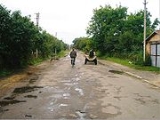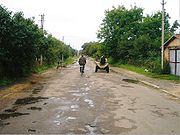
Tuczyn
Encyclopedia
Tuchyn is a village
in the Rivne Oblast
(province
) of western Ukraine. It is located in the Rivne Raion
(district
) in the historic region of Volhynia
, approximately 18 km east from the oblast capital, Rivne
.

, it had a large Jewish, Polish and Ukrainian
population. A Roman Catholic Parish was founded in Tuczyn in 1590, it included the surrounding villages of Buhryński Majdan, Cecylówka, Drozdów, Horbów, Jadzin, Karczemka, Korościatyn, Krąglik, Kryniczka, Kudranka, Kuty Zalesie, Leonówka, Lucynów, Mikulin, Niespodzianka: I, II, III; Piotrowica, Podobanka, Pustomycki Majdan, Pustomyty Ryświanka, Rzeczyca, Sienne, Smolarnia, Sobówka dwór, Urszulin, Woronów, Woskodawy, and Zalanka. In 1938 the Catholic Parish numbered 2,660 individuals, almost all of them Poles
.
In addition to the foregoing, there was a significant German population in the Tuczyn region prior to World War II. They began to arrive in large numbers in the 1860s. The vast majority were German Lutherans, initially served from distant Zhitomir Lutheran Parish. The Lutheran Parish of Tuczyn was established there in 1888. At its peak, prior to World War I, the parish served over 25,000 Germans in more than 80 villages in a region much larger than that covered by the Catholic Church - yet no church building was constructed until 1929. The numbers of Germans dropped dramatically before World War I, with many migrating to North America. Only some 6000 or so remained during the inter-war years.
's, and finally by the Walewski's from the 18th century to the outbreak of World War II. The Stanisław Lubomirski foundation erected two wooden churches, cerkwie, in the town in 1711 (Paraskewy) and 1730 (Przemienienia Pańskiego). The Walewski's built a classicist Church in 1796.
Tuczyn was a major town in the district prior to World War II. It had major populations of Jews, Poles, Ukrainians and some Germans.
Village
A village is a clustered human settlement or community, larger than a hamlet with the population ranging from a few hundred to a few thousand , Though often located in rural areas, the term urban village is also applied to certain urban neighbourhoods, such as the West Village in Manhattan, New...
in the Rivne Oblast
Rivne Oblast
Rivne Oblast is an oblast of Ukraine. Its administrative center is Rivne. The area of the region is 20,100 km²; its population is 1.2 million...
(province
Oblast
Oblast is a type of administrative division in Slavic countries, including some countries of the former Soviet Union. The word "oblast" is a loanword in English, but it is nevertheless often translated as "area", "zone", "province", or "region"...
) of western Ukraine. It is located in the Rivne Raion
Rivne Raion
Rivne Raion is a raion in Rivne Oblast in western Ukraine. Its administrative center is Rivne. It has a population of 87 091.-External links:*...
(district
Raion
A raion is a type of administrative unit of several post-Soviet countries. The term, which is from French rayon 'honeycomb, department,' describes both a type of a subnational entity and a division of a city, and is commonly translated in English as "district"...
) in the historic region of Volhynia
Volhynia
Volhynia, Volynia, or Volyn is a historic region in western Ukraine located between the rivers Prypiat and Southern Bug River, to the north of Galicia and Podolia; the region is named for the former city of Volyn or Velyn, said to have been located on the Southern Bug River, whose name may come...
, approximately 18 km east from the oblast capital, Rivne
Rivne
Rivne or Rovno is a historic city in western Ukraine. It is the administrative center of the Rivne Oblast , as well as the administrative center of the surrounding Rivne Raion within the oblast...
.

Tuchyn Diversity
Tuchyn was a very diverse town. Before World War IIWorld War II
World War II, or the Second World War , was a global conflict lasting from 1939 to 1945, involving most of the world's nations—including all of the great powers—eventually forming two opposing military alliances: the Allies and the Axis...
, it had a large Jewish, Polish and Ukrainian
Ukrainians
Ukrainians are an East Slavic ethnic group native to Ukraine, which is the sixth-largest nation in Europe. The Constitution of Ukraine applies the term 'Ukrainians' to all its citizens...
population. A Roman Catholic Parish was founded in Tuczyn in 1590, it included the surrounding villages of Buhryński Majdan, Cecylówka, Drozdów, Horbów, Jadzin, Karczemka, Korościatyn, Krąglik, Kryniczka, Kudranka, Kuty Zalesie, Leonówka, Lucynów, Mikulin, Niespodzianka: I, II, III; Piotrowica, Podobanka, Pustomycki Majdan, Pustomyty Ryświanka, Rzeczyca, Sienne, Smolarnia, Sobówka dwór, Urszulin, Woronów, Woskodawy, and Zalanka. In 1938 the Catholic Parish numbered 2,660 individuals, almost all of them Poles
Poles
thumb|right|180px|The state flag of [[Poland]] as used by Polish government and diplomatic authoritiesThe Polish people, or Poles , are a nation indigenous to Poland. They are united by the Polish language, which belongs to the historical Lechitic subgroup of West Slavic languages of Central Europe...
.
In addition to the foregoing, there was a significant German population in the Tuczyn region prior to World War II. They began to arrive in large numbers in the 1860s. The vast majority were German Lutherans, initially served from distant Zhitomir Lutheran Parish. The Lutheran Parish of Tuczyn was established there in 1888. At its peak, prior to World War I, the parish served over 25,000 Germans in more than 80 villages in a region much larger than that covered by the Catholic Church - yet no church building was constructed until 1929. The numbers of Germans dropped dramatically before World War I, with many migrating to North America. Only some 6000 or so remained during the inter-war years.

History
The Polish noble family Siemaszko is rooted in Tuchyn. In 1650 the town was owned by the Daniłłowicz family, then later by the LubomirskiLubomirski
Lubomirski family is a Polish szlachta family. The family used the "Szreniawa without a cross" arms and their motto was: Nil conscire sibi ....
's, and finally by the Walewski's from the 18th century to the outbreak of World War II. The Stanisław Lubomirski foundation erected two wooden churches, cerkwie, in the town in 1711 (Paraskewy) and 1730 (Przemienienia Pańskiego). The Walewski's built a classicist Church in 1796.
Tuczyn was a major town in the district prior to World War II. It had major populations of Jews, Poles, Ukrainians and some Germans.
WWII
Prior to World War II about 3,000 Jews lived in Tuczyn. After hearing of the annihilation of the Jewish Ghetto in Rivne the Jewish leaders decided that they would resist the Nazis. On the evening of Tuesday, September 23, 1942, a blockade was mounted against the ghetto of Tuczyn. The leaders of the uprising declared a full alert; the fighting groups took up positions. On the dawn of September 24, German forces and Ukrainian auxiliaries advanced toward the ghetto fences. When the resistance forces gave the signal, the buildings of the ghetto and the German warehouses at its edge were set ablaze. The fighting groups opened fire, broke through the ghetto fence, and urged the population to escape. Under cover of smoke and gunfire, some 2,000 people-about two-thirds of the ghetto population, including women, children, and the elderly-fled into the forest. The flames continued to burn for the rest of that day and part of the next; the gunfire continued as well. Several Germans and Ukrainian auxiliary police were killed. One-third of the ghetto population fell, including almost all the fighters. The uprising ended on Saturday, September 26 when the lead resistors turned themselves into the Germans, unable to stand the conditions in the nearby forests. The escapees fared very badly. Half of them were captured and murdered within three days. About 300 women, clutching infants, unable to withstand the conditions of the forest, returned to Tuczyn and were shot. Many of the remainder died; others were turned in or murdered by peasants in the vicinity. Some young people joined the partisans and were killed in combat. Of the 3,000 Jews of Tuczyn, only 20 were still alive on January 16, 1944, when the town was liberated.Links
- 1923 Tuczyn Business directory http://www.shtetlinks.jewishgen.org/tuchin/TuchinBD.htm#LETC
- September 24: Uprising in Tuczyn Ghetto http://yad-vashem.org.il/about_holocaust/chronology/1942-1945/1942/chronology_1942_33.html
- Tuczyn Lutheran Parish History http://www.sggee.org/parish_histories/VolhyniaDiocese/TutschinParish/TutschinHist.html
- Description of events in Tuczyn during World War II http://motlc.learningcenter.wiesenthal.org/text/x33/xr3308.html

